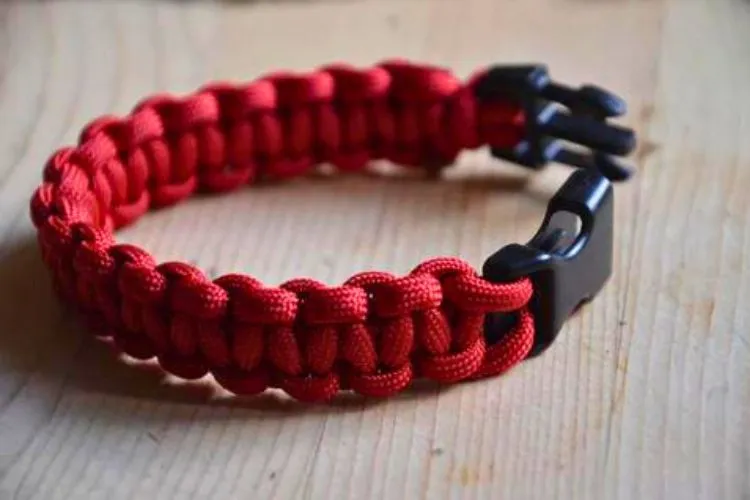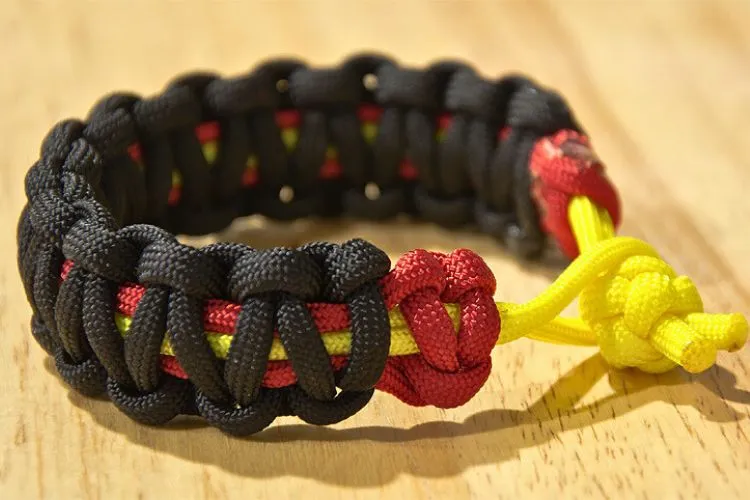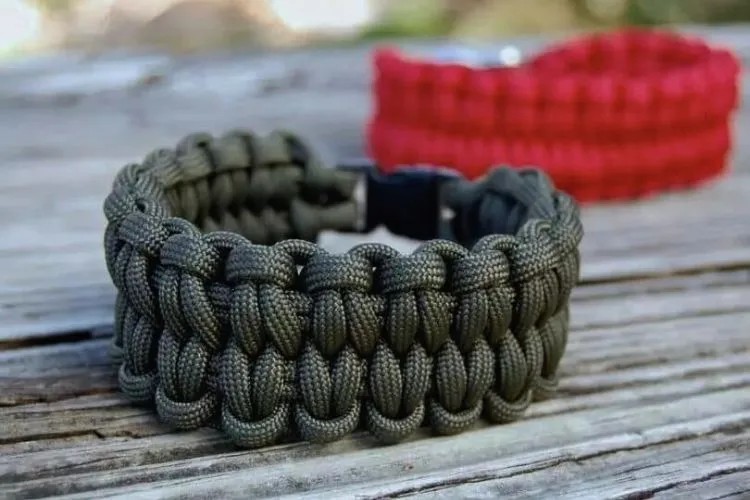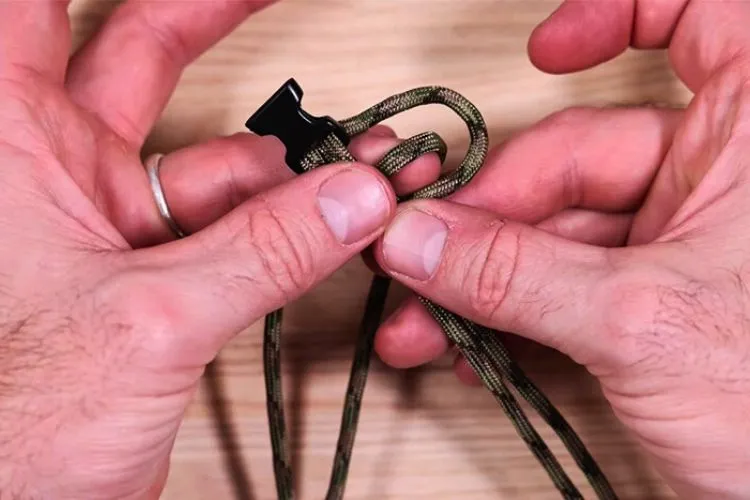Paracord bracelets have gained popularity as functional accessories for outdoor enthusiasts and survivalists.
But, do you know how do paracord bracelets work?
In this comprehensive guide, we will explore the composition and construction of paracord bracelets, their various uses and benefits, and provide step-by-step instructions on how to make your own.

If you’ve ever wondered about the functionality and versatility of these bracelets, you’ve come to the right place.
How do paracord bracelets work?
Paracord bracelets work by utilizing the strength and versatility of the parachute cord, also known as paracord. The cord is braided or woven into a specific pattern to create a bracelet.
The key components of a paracord bracelet are the inner core and the inner strands. The inner core is made of strong nylon fibers, while the inner strands consist of multiple intertwined nylon strands. The number of inner strands can vary, typically ranging from 2 to 9.
When wearing a paracord bracelet, it appears as a stylish accessory.
However, when needed, the bracelet can be unraveled to provide a length of cord that can be used for various purposes. The total length of usable cord is significantly greater than the length of the bracelet because of the inner core and inner strands.
To unravel a paracord bracelet, you typically need to locate the ends that are secured by the buckle and carefully unweave or cut the stitches. This process allows you to access the cord hidden within the bracelet.
The uses of a paracord bracelet are extensive and can be essential in survival and outdoor situations.
The unraveled cord can be utilized for tasks such as securing gear, creating emergency shelters, constructing splints, making tourniquets, fishing, and starting fires. The strength and durability of the cord make it a reliable resource in challenging conditions.
In emergency situations, it is crucial to have a reliable tool like a paracord bracelet that can provide you with a length of cord for various survival needs. Being prepared with a paracord bracelet means having a functional and versatile tool always at hand.
To use the cord for any task, you need to physically unravel the bracelet and detach the desired length of cord from the rest. This can be easily achieved by unweaving or cutting the stitches, allowing you to access the cord contained within the bracelet.
By understanding how paracord bracelets work, you can fully utilize their functionality, ensuring that you have a valuable tool ready for any situation.
Whether it’s securing equipment, creating shelter, or providing medical support, a paracord bracelet offers peace of mind and a reliable resource in times of need.
Composition and Construction of Paracord Bracelets
Paracord bracelets are made using a special type of cord known as parachute cord or paracord. This cord is made of nylon and was initially used in the suspension lines of parachutes. It offers unbeatable strength and durability, making it ideal for survival situations.

Inside a paracord bracelet, you’ll find an inner core and inner strands. The inner core is typically made of strong nylon fibers, while the inner strands are composed of multiple intertwined nylon strands.
The number of inner strands can vary, with bracelets often containing between 2 to 9 strands. The inner strands are essential because they significantly increase the total length of usable cord in the bracelet.
To create a paracord bracelet, the cord is braided or woven in a specific pattern. One of the most common patterns used is the cobra stitch or Solomon bar. This pattern results in a tightly woven bracelet that is both aesthetically pleasing and functional.
Uses and Benefits of Paracord Bracelets
Paracord bracelets are incredibly versatile tools, and their uses in outdoor and survival situations are virtually limitless. Here are some of the most common uses and benefits of paracord bracelets:

- Securing Gear: Paracord bracelets can be unraveled to provide a length of cord for securing items. Whether it’s tying down a tarp, creating a clothesline, or securing gear to a backpack, the cord from a paracord bracelet proves invaluable.
- Emergency Shelter: Survival situations may require you to construct a shelter quickly, and paracord bracelets can assist with this. By unraveling the bracelet, you can use the cord to create a sturdy shelter using natural resources.
- Securing a Splint: In case of injury, paracord can be used to create a makeshift splint. The elasticity and strength of the cord provide support and stability until proper medical assistance is available.
- Emergency Tourniquet: In extreme situations where severe bleeding occurs, a paracord bracelet can be used as an improvised tourniquet to temporarily stop the bleeding and prevent further injury.
- Fishing Line: In survival situations, food procurement may become a priority. Paracord bracelets often contain inner strands that can be used as fishing line, increasing your chances of catching a meal.
- Fire Starters: Paracord bracelets often include a flint or fire starter tool, making it easier to start a fire when necessary. These fire starters can produce sparks even in adverse weather conditions.
- Zipper Pulls and Lanyards: Paracord bracelets are not just for emergencies. Many people enjoy using them as zipper pulls on backpacks or as stylish lanyards for holding keys, flashlights, and other small items.
Making and Unraveling a Paracord Bracelet
Now that you understand the uses and benefits of paracord bracelets, let’s delve into the process of making your own and unraveling them for emergency use.
Making a Paracord Bracelet
To create a basic paracord bracelet using the cobra stitch, follow these steps:

- Measure your wrist: Wrap a measuring tape or a piece of string around your wrist to determine the desired length of the bracelet.
- Cut the cord: Using scissors, cut the measured length of paracord. Remember to leave a bit of extra length for adjustments.
- Seal the ends: To prevent fraying, use a lighter to melt the cut ends of the cord. Press the melted ends with a metal object to smoothen them out.
- Begin braiding: Fold the cord in half and find the midpoint. Slide the midpoint through one end of the buckle and pull the two loose ends through the loop created.
- Continue braiding: Alternate the sides by taking the left strand over the middle strands and under the right strand. Repeat this step until the desired length is reached.
- Finishing touches: Once the desired length is achieved, secure the ends by threading them through the opposite buckle. Trim any excess cord and melt the ends.
Unraveling a Paracord Bracelet
In emergency situations where you need the cord, follow these steps:
- Find the ends: Locate the ends of the bracelet where it is secured by the buckle.
- Unweave or cut the stitches: Using your fingers or a sharp object, carefully unweave or cut the stitches of the bracelet until you have enough cord for your needs.
- Utilize the cord: Make use of the unraveled cord for any emergency situation, such as securing gear, creating shelters, or any other survival need.
Frequently Asked Questions (FAQs)
How to unravel a paracord bracelet?
To unravel a paracord bracelet, locate the ends that are secured by the buckle and carefully unweave or cut the stitches until you have the desired length of cord.
What are the common uses for paracord bracelets?
Paracord bracelets have numerous uses, including but not limited to securing gear, creating emergency shelters, splinting injuries, making emergency tourniquets, fishing, and starting fires.
How to make a paracord bracelet?
To make a paracord bracelet, you’ll need to measure your wrist, cut the cord to the desired length, melt the ends to prevent fraying, and use the cobra stitch or other weaving techniques to create the desired design.
How to use a paracord bracelet in an emergency?
In an emergency, a paracord bracelet can be unraveled to provide cord length for tasks such as securing gear, constructing shelters, creating tourniquets, splinting injuries, and more.
How to use a survival bracelet to start a fire?
Many paracord bracelets come equipped with a flint or fire starter. By striking the flint against the metal, sparks are produced, thus igniting any combustible material nearby, allowing you to start a fire.
Conclusion:
Paracord bracelets are more than just stylish accessories; they are practical tools that can be a lifesaver in outdoor and survival situations.
By understanding their composition, construction, and various uses, you can unlock the full potential of these bracelets.
Armed with the knowledge of how to create and unravel them, you’ll be prepared for any adventure or emergency situation that comes your way.
So, go ahead, craft your own paracord bracelet, and embark on your next adventure with confidence.


